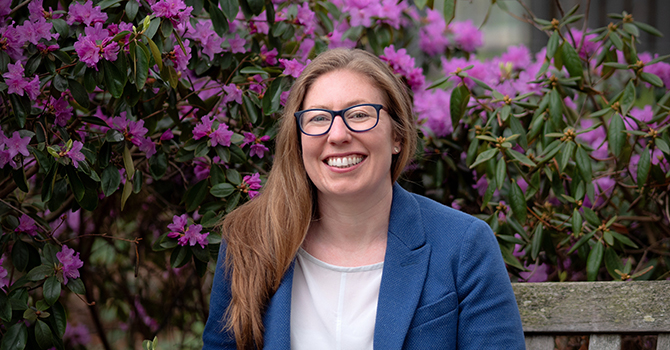Frogs, Brains, and Team Science

Kelly M. Bakulski
Research Assistant Professor
As far back as I can remember, I wanted to be outside. And I think that’s what led to my deep interest in the environment and more generally, in science. At Colby College, my undergraduate majors were ecology, the largest unit of biology, and molecular biology, the smallest unit. I couldn't decide—I was curious about the science of life.
Colby is a wonderful liberal arts college in rural Maine, and I was able to gain research experience right off the bat. My advisor, Catherine Bevier, took a chance on me as a freshman and kept me on for four years.
Dr. Bevier runs a herpetology lab, primarily focused on frogs. We tested the anti-microbial chemicals they have on their skin for protection against the chytrid fungus, a major pandemic affecting nearly all frog species around the globe. She showed me science in action in the forest at night and the molecular laboratory during the day.
In retrospect, I was doing environmental epidemiology before I knew what it was.
Since finding the language of environmental epidemiology during graduate school at Michigan, I haven’t had to choose between those small and large units of biology.
Since finding the language of environmental epidemiology during graduate school at Michigan, I haven’t had to choose between those small and large units of biology. Now in my own lab, we study the brain and what leads to brain diseases. I look at the brain from all angles—from my “environment side” and from my “molecular side”—trying to identify risk factors for neurological disorders that might be coming from genetic or environmental factors (or both).
Research Is Teaching and Learning
My interest in the brain stemmed from personal experience. For my doctoral training, I investigated environmental risk factors for Alzheimer’s disease. We observed that not everyone exposed to the same level of a chemical had the same risk of disease. Understanding the effects of the environment depended on a person’s genetic context. It was clear that I needed more quantitative genetics experience to be able to see the whole picture.
A postdoctoral fellowship at Johns Hopkins allowed me to train in statistical genetics and genetic epidemiology. In the context of autism spectrum disorder, we observed that some risk was associated with genetic factors, other risk with exposures during pregnancy, and in many cases, both sources. Working with childhood development cohorts in the autism lab was also valuable for connecting with the early side of the life course.
My students and I investigate early development and later life periods. We see many overlapping risk factors and pathological processes—some happening in reverse—on the two ends of the life course. Exposures that are damaging for your brain during those early sensitive periods might also cause problems later, during more vulnerable stages when systems are winding down. We consider genetics, exposures, and their timing together.
Brain health and how it connects to the health of the body is still a frontier for science. We are constantly learning new things about the brain, so I get to reshape my thinking frequently.
Biggest Challenge, Biggest Reward
I’ve spent most of my life as an avid learner from inspiring teachers. Receiving the Excellence in Teaching Award myself this year was a genuine and wonderful surprise.
Relative to rigorous research training, graduate students often receive less didactic teaching preparation. Knowing how to organize a class well, how to design an assessment—how to ensure students can learn in my classes—is really important to me. As a nascent teacher, I knew I needed help. I found it at the amazing Instructional Services here at the school. They showed me how to bring the latest educational research into classroom practice.
For me, the anticipation before teaching each class is still nerve-wracking. Michigan students have energizing public health goals and it's a huge responsibility to provide tools for positive change. It’s essential for me to have strong teaching materials for students and to create a positive learning environment. I find joy in breaking down complex epidemiology problems into logical pieces and enormous gratification when all of these elements come together in student growth.
It’s a particular honor to receive a teaching award since teaching initially was a tremendous challenge for me. While learning how to teach, I’ve connected with generous members of our public health community, including our senior faculty who modeled effective methods for teaching our students and our junior faculty who are willing to innovate in the classroom and share their results.
A big part of what drew me back was the school’s emphasis on the idea that we can better tackle big problems together than individually.
Teamwork in Science
I’ve found that my students’ learning skyrockets when they’re engaged with the material. I emphasize collaboration and experimentation, lecturing only for about 30 minutes and then using the rest of our time for interactive computer labs. While we work through problems on the big screen, students are expected to brainstorm and test out solutions with neighbors. We’re all seeing what other people are discovering and learning as we go.
Three years ago, I returned to Michigan as a faculty member. A big part of what drew me back was the school’s emphasis on the idea that we can better tackle big problems together than individually. That attitude is so prevalent here and it is something that sets Michigan apart. It comes through in our research in teams, and it comes through in the classroom.
I’m a teamwork kind of person—it’s the best environment for me as a teacher and as a researcher. And I think in nearly all cases, a team approach is really good for science. I’m excited about the future of public health that teams of our current students will bring forward.
